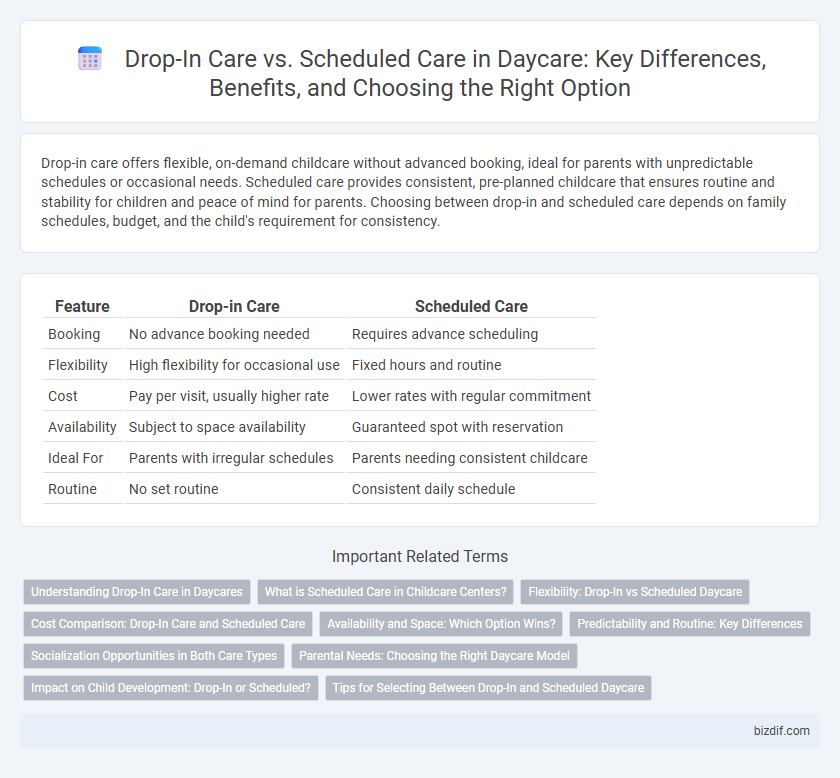Drop-in care offers flexible, on-demand childcare without advanced booking, ideal for parents with unpredictable schedules or occasional needs. Scheduled care provides consistent, pre-planned childcare that ensures routine and stability for children and peace of mind for parents. Choosing between drop-in and scheduled care depends on family schedules, budget, and the child's requirement for consistency.
Table of Comparison
| Feature | Drop-in Care | Scheduled Care |
|---|---|---|
| Booking | No advance booking needed | Requires advance scheduling |
| Flexibility | High flexibility for occasional use | Fixed hours and routine |
| Cost | Pay per visit, usually higher rate | Lower rates with regular commitment |
| Availability | Subject to space availability | Guaranteed spot with reservation |
| Ideal For | Parents with irregular schedules | Parents needing consistent childcare |
| Routine | No set routine | Consistent daily schedule |
Understanding Drop-In Care in Daycares
Drop-in care in daycares offers flexible childcare services without the need for advance reservations, allowing parents to access care on an as-needed basis. This type of care accommodates irregular schedules and unexpected commitments while providing children with consistent social interaction and supervised activities. Understanding the differences between drop-in care and scheduled care helps families choose the most convenient and cost-effective childcare option.
What is Scheduled Care in Childcare Centers?
Scheduled care in childcare centers refers to a structured and pre-arranged enrollment where parents reserve specific days and hours for their child's attendance, ensuring consistent supervision and routine. This type of care supports developmental stability by providing regular interaction with caregivers and peers, aligning with the child's learning and socialization needs. Enrollment in scheduled care often involves contractual agreements and predictable fees, enabling better planning for both families and childcare providers.
Flexibility: Drop-In vs Scheduled Daycare
Drop-in daycare offers unparalleled flexibility by allowing parents to use childcare services on an as-needed basis without prior commitment, ideal for unpredictable schedules. Scheduled daycare requires advance booking and provides consistent care during fixed hours, supporting routine and long-term planning. Choosing between drop-in and scheduled care depends on a family's specific needs for flexibility versus stability.
Cost Comparison: Drop-In Care and Scheduled Care
Drop-in care typically costs more per hour than scheduled care due to its flexible, on-demand nature, making it ideal for occasional use but less budget-friendly for regular attendance. Scheduled care offers lower rates through set weekly or monthly commitments, providing families with predictable expenses and potential discounts for full-time enrollment. Evaluating the frequency and consistency of childcare needs is crucial when comparing cost-effectiveness between drop-in and scheduled care options.
Availability and Space: Which Option Wins?
Drop-in care offers flexible availability, allowing parents to access childcare services on short notice without prior booking, ideal for unpredictable schedules. Scheduled care guarantees a reserved space, providing consistent and reliable access, especially crucial in high-demand facilities where drop-in spots may be limited. When comparing availability and space, scheduled care wins for ensuring guaranteed placement, while drop-in care excels in flexibility but faces potential space constraints.
Predictability and Routine: Key Differences
Drop-in care offers flexibility for parents needing occasional childcare without prior booking, accommodating unpredictable schedules but lacking consistent routines. Scheduled care provides predictable, regular attendance fostering stable daily routines essential for children's development and security. Establishing a consistent routine in scheduled daycare supports emotional well-being and cognitive growth by creating a structured environment.
Socialization Opportunities in Both Care Types
Drop-in care offers flexible socialization opportunities through varied interactions with different children, promoting adaptability and diverse social skills. Scheduled care provides consistent peer groups, fostering deeper friendships and sustained social development. Both care types contribute uniquely to children's social growth by balancing dynamic exposure and stable relationships.
Parental Needs: Choosing the Right Daycare Model
Drop-in care offers unparalleled flexibility for parents with unpredictable schedules, allowing them to access childcare on an as-needed basis without long-term commitments. Scheduled care provides consistent routines essential for children's developmental stability and supports parents with regular work hours seeking reliable daily care. Evaluating parental needs, including work patterns and desired stability, helps determine the optimal daycare model for family well-being.
Impact on Child Development: Drop-In or Scheduled?
Scheduled care provides consistent routines and predictable social interactions essential for emotional stability and cognitive growth, fostering secure attachments and steady developmental progress. Drop-in care offers flexibility but may disrupt daily rhythms, potentially leading to stress and delayed social skill acquisition due to inconsistent peer engagement. Research indicates that stability and routine in scheduled daycare significantly enhance language development, executive function, and behavioral regulation compared to irregular drop-in attendance.
Tips for Selecting Between Drop-In and Scheduled Daycare
When choosing between drop-in care and scheduled daycare, consider your child's routine stability and your flexibility needs. Drop-in care offers convenience for occasional use, while scheduled care ensures consistent socialization and structured activities, benefiting long-term development. Evaluate the daycare's availability, staff qualifications, and your family's budget to make an informed decision tailored to your child's well-being.
Drop-in care vs Scheduled care Infographic

 bizdif.com
bizdif.com